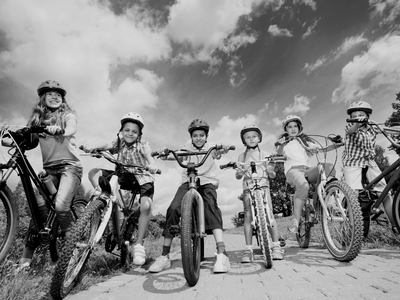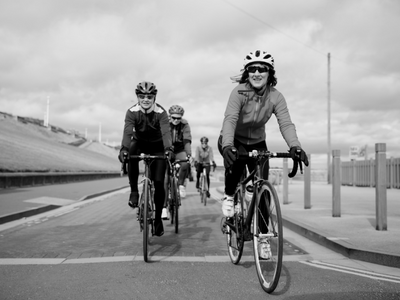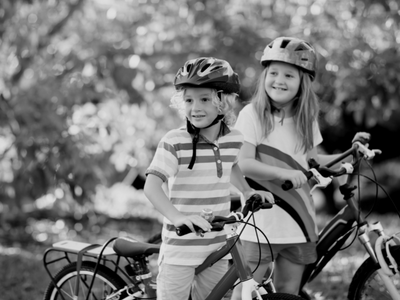February 18, 2022
by Molly Hurford
In recent years, more and more girls have been getting on bikes. But there’s so much more that we can be doing to encourage girls to come out to bike practices, join group rides and skills sessions, and simply learn to play on bikes. Whether you’re a parent of a young girl and you want to help encourage her to ride, or you’re a coach or club member who wants to reach more young girls and get them into the sport, read on for some advice from a few women who’ve been bringing girls into cycling!
Check your website and social media

If you don’t have girls joining your programs, it may be because they don’t feel like your programs are open to them. Representation is so important, and that means making sure girls on bikes are featured in your posts and program descriptions.
“I think organizations need to ensure they are sharing images and media that are equally balanced girl/boy,” says Kate Sparling Holmes, one of the founders of the Collingwood Off-Road Cycling Club (CORC). “Girls need to see other girls riding!”
Ensure girls find out about programs
You can make all the girls-only programs you want, but if girls aren’t hearing about them, that’s not very helpful. In fact, in any cycling club, often kids programming exists in an echo chamber: It’s only shared with club members, so only club members’ kids join the program. But that means if a parent doesn’t ride seriously, the kids have almost no way to hear about cycling!
So be proactive: Ask schools and other youth programs to spread the word about your kid’s cycling sessions. Consider dropping flyers at libraries, dance studios, gymnastics gyms, and even local gyms where non-cycling parents might see. Contact local newspapers and websites, and even consider posting in local parenting Facebook Groups.

Do more one-time sessions/ride
Don’t force immediate commitment, especially for kids. The more one-day opportunities you can put on the schedule for girls to come to, the better: It’s easier to try a day of biking than it is to sign up for a 10-week program when you’ve never ridden before and you’re nervous.
Create girls-only opportunities
but not only girls-only opportunities
When getting started in cycling, it’s usually easier to be surrounded by similar others, which is why all-girl groups can be so helpful. “All girl camps or groups are important, as mixing in with the boys at this age can be a deal-breaker,” says Noelle Wansbrough, the founder of Pedal Pushers and force behind girls programming in Collingwood that’s seen hundreds of young girls get on mountain bikes. “Girls in their pre-teen and teen years are easily intimidated so a comfortable fun atmosphere where the focus is on learning and development.”
While hosting girls-only camps is important, consider making your other programming very specifically co-ed, so that girls are able to choose to be in a group of girls or in with the boys. Plenty of young girls gets into cycling because a boy that they’re friends with is also riding, and separating them may do more harm than good (and the same is true for siblings). There’s so much that girls can learn from riding with different people—boys included!—so don’t force them to stay in all-girls groups if they don’t want to.
Help with equipment
Biking is expensive, and for non-cycling parents, it can be incredibly confusing to figure out what kind of bike their kids need in order to participate in the program, so try to make things as easy as possible. Setting up a forum for club members to sell their kid’s old bike gear is a great way to help new young riders while letting parents get rid of those too-small bikes.
You also might want to develop a simple email that lists the exact type of bike and any clothing needs a child would need to get started. If you really want to bring more kids to a program, especially girls who are hesitant about trying biking, having some bikes available to borrow is a great investment (and you may even find you get plenty of donations if you ask!)
...and explain the equipment
When girls are uncomfortable on the bike, they’re less inclined to want to keep riding. Things you take for granted like a seat that’s the right height, tires that are pumped up, bike shorts with an actual chamois pad (and no underwear!) can make a big difference. And if a girl doesn’t have parents who are into cycling, she may not know any of this—so try to gently give them tips without overwhelming them.
If you have girls in the program, ask what they like and what they would change
Already have some girls in your program? Why not see what’s keeping them in and if there’s anything that they would change that could potentially make their riding more fun… And make them more inclined to bring friends. You can also do things like hosting a ‘bring a friend’ day with bikes available to borrow so that the girls can actually bring more girls. Enlisting the girls you do have to bring more girls to the program can make a big difference. “It’s always helpful to have the one participant who is a leader and can convince her friends to join her. At this age it is all about what your friends are doing so if there’s a bunch of girls signing up for a camp and it’s the ‘thing’ to do, it’s much easier to round up a solid group of girls,” says Wansbrough.
If girls leave, try to find out why

When you have girls leave the program, it can be difficult to ask for constructive criticism, but this is the perfect way to learn about what’s not working. Of course, not all of their problems can be solved: lots of kids drop out simply because they get busy with other activities. But you may find that there’s something that girls are missing in your practices that you can tweak or fix—or that there’s a problem you’ve been unaware of.
Reach out to the girls’ parents to try to find out what made them quit. (The same applies for girls who seem interested in one practice, but don’t come back. You may not get them back, but at least you’ll learn what made them want to quit.)
Set up mentorship programs
Make practice fun
“It is very important the girls have strong mentors and the program needs to feel non-threatening and safe,” says Wansbrough. The buddy system is a powerful thing and can keep younger and older girls committed to the sport. If you have a program that has a range of ages, consider pairing each younger girl with an older girl as a mini-mentorship program. The young girl will have someone to look up to, and the older girl will be able to share her experience and likely improve her riding as a result.
Sparling Holmes has a seven-year-old daughter who loves to shred on her mountain bike. What makes her love practicing? “More games!” When programs focus too much on drills and hard riding, girls and boys alike get bored. You can still do drills, but make them more fun and goofy, rather than tough. (Her daughter also recommends making time for snacks, and also having dogs at practices.)
stress fun, not racing
It’s tempting to have youth programs that are racing-focused, and that’s not a bad thing… But kids (and even teens) should be focusing on the fun of riding rather than race results. Even if your club is competitive, focus on the fun and health benefits of riding while prepping for competition. Girls (and boys) can still race hard, of course, but it should be done with joy, not stress or fear. “Riding with friends and family or in a program needs to be fun and our experience says that we do well to encourage but not cross the line into pressuring our daughter,” says Sparling-Holmes.
“To ride, or not, needs to always be her choice. Riding as a family activity brings us all a lot of joy and takes us on great adventures. I think exposing our nature-loving kids to new forests, trails, and communities by bike is fun and exciting for them and then gets us all talking about and planning the next adventure!”
About the writer:
Molly Hurford is a journalist in love with all things cycling, running, nutrition and movement-related. When not outside, she’s writing about being outside and healthy habits of athletes and interviewing world-class athletes and scientists for The Consummate Athlete podcast and website, and most recently launched the book ‘Becoming A Consummate Athlete.‘ She’s the author of multiple books including the Shred Girls, a young adult fiction series and online community focused on getting girls excited about bikes.
Molly is a little obsessed with getting people psyched on adventure and being outside, and she regularly hosts talks and runs clinics for cyclists and teaches yoga online and IRL… And in her spare time, the former Ironman triathlete now spends time tackling long runs and rides on trails or can be found out hiking with her mini-dachshund DW and husband, cycling coach and kinesiologist Peter Glassford.
